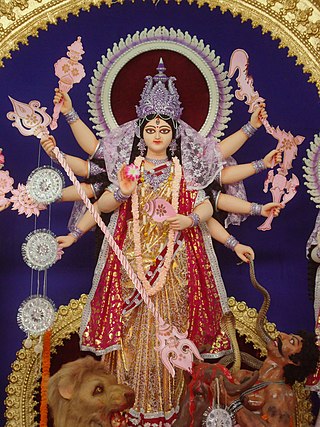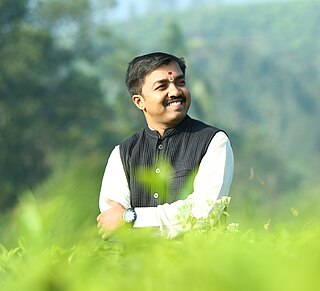
Adi Shankara, also called Adi Shankaracharya, was an Indian Vedic scholar and teacher (acharya). His works present a harmonizing reading of the sastras, with liberating knowledge of the self at its core, synthesizing the Advaita Vedanta teachings of his time.

Thyagaraja, also known as Thyāgayya and in full as Kakarla Thyagabrahmam, was a composer and vocalist of Carnatic music, a form of Indian classical music. Tyagaraja and his contemporaries, Shyama Shastri and Muthuswami Dikshitar, are regarded as the Trinity of Carnatic music. Tyagaraja composed thousands of devotional compositions, most in Telugu and in praise of Rama, many of which remain popular today, the most popular being "Nagumomu". Of special mention are five of his compositions called the Pancharatna Kritis, which are often sung in programs in his honour, and Utsava Sampradaya Krithis, which are often sung to accompany temple rituals.

The Vishnu Sahasranama, is a Sanskrit hymn containing a list of the 1,000 names of Vishnu, one of the main deities in Hinduism and the Supreme God in Vaishnavism. It is one of the most sacred and popular stotras in Hinduism. The most popular version of the Vishnu Sahasranama is featured in the Anushasana Parva of the epic Mahabharata. Other versions exist in the Padma Purana, the Skanda Purana, and the Garuda Purana. There is also a Sikh version of the Vishnu Sahasranama found in the work Sundar Gutka.
Om Namah Shivaya is one of the most popular Hindu mantras and the most important mantra in Shaivism. Namah Shivaya means "O salutations to the auspicious one!", or "adoration to Lord Shiva". It is called Siva Panchakshara, or Shiva Panchakshara or simply Panchakshara meaning the "five-syllable" mantra and is dedicated to Shiva. This Mantra appears as 'Na' 'Ma' 'Śi' 'Vā' and 'Ya' in the Shri Rudram Chamakam which is a part of the Krishna Yajurveda and also in the Rudrashtadhyayi which is a part of the Shukla Yajurveda.

Bhaja Govindam, also known as Moha Mudgara, is a popular Hindu devotional poem in Sanskrit composed by Adi Shankara. This work of Adi Shankara underscores the view that bhakti (devotion) is also important along with jñāna (knowledge), as emphasised by the Bhakti movement.

Tripura Sundari, also known as Rajarajeshvari, Shodashi, Kamakshi, and Lalita is a Hindu goddess, revered primarily within the Shaktism tradition and recognized as one of the ten Mahavidyas. She embodies the essence of the supreme goddess Mahadevi. Central to the Shakta texts, she is widely praised in the Lalita Sahasranama and Saundarya Lahari. In the Lalitopakhyana of the Brahmanda Purana, she is referred to as Adi Parashakti.
Sahasranāma is a Sanskrit term which means "a thousand names". It is also a genre of stotra literature, usually found as a title of the text named after a deity, such as Vishnu Sahasranāma, wherein the deity is remembered by 1,000 names, attributes or epithets.

The Shiva Tandava Stotra(m) (Sanskrit: शिवताण्डवस्तोत्र, romanized: śiva-tāṇḍava-stotra) is a Sanskrit religious hymn (stotra) dedicated to the Hindu deity Shiva, one of the principal gods in Hinduism and the supreme god in Shaivism. Its authorship is traditionally attributed to Ravana, the ruler of Lanka, considered a devotee of Shiva.

The Brahmanda Purana is a Sanskrit text and one of the eighteen major Puranas, a genre of Hindu texts. It is listed as the eighteenth Maha-Purana in almost all the anthologies. The text is also referred in medieval Indian literature as the Vayaviya Purana or Vayaviya Brahmanda, and it may have been same as the Vayu Purana before these texts developed into two overlapping compositions.
Shanmata meaning "Six Sects" in Sanskrit, is a system of worship, believed by the Smarta tradition to have been founded by Adi Shankara, [circa 8th Century CE] Hindu philosopher. It centers around the worship of the six main deities of Hinduism, Shiva, Vishnu, Shakti, Ganesha, Surya and Skanda. In this system, six major deities are worshipped. This is based on the belief in the essential oneness of all deities, the unity of Godhead, and their conceptualization of the myriad deities of India as various manifestations of the one divine power, Brahman.
Adi Shankara, a Hindu philosopher of the Advaita Vedanta school, composed a number of commentarial works. Due to his later influence, a large body of works that is central to the Advaita Vedanta interpretation of the Prasthanatrayi, the canonical texts consisting of the Upanishads, the Bhagavad Gita and the Brahma Sutras, is also attributed to him. While his own works mainly consist of commentaries, the later works summarize various doctrines of the Advaita Vedanta tradition, including doctrines that diverge from those of Adi Shankara.
Manisha Panchakam is a stotra containing five verses (slokas) composed by Shri Adi Shankaracharya, the Hindu philosopher. It is said that in these five verses Shankara brings out the essence of Advaita Vedanta.

The Ganapati Atharvasirsha is a Sanskrit text and a minor Upanishad of Hinduism. It is a late Upanishadic text dedicated to Ganesha, the deity representing intellect and learning. It asserts that Ganesha is same as the eternal underlying reality, Brahman. The text is attached to the Atharvaveda, and is also referred to as the Sri Ganapati Atharva Sirsha, the Ganapati Atharvashirsha, the Ganapati Atharvasirsa, or the Ganapati Upanishad.

The Dakshinamurti Stotra is a Sanskrit religious hymn (stotra) to Shiva attributed to Adi Shankara. It explains the metaphysics of the universe in the frame of the tradition of Advaita Vedanta.

Ganesha, also spelled Ganesh, and also known as Ganapati, Vinayaka, and Pillaiyar, is one of the best-known and most worshipped deities in the Hindu pantheon and is the Supreme God in the Ganapatya sect. His depictions are found throughout India. Hindu denominations worship him regardless of affiliations. Devotion to Ganesha is widely diffused and extends to Jains and Buddhists and beyond India.

Shakti is the fundamental cosmic energy and a central deity within Shaktism, a significant theological tradition of Hinduism. Representing dynamic forces that permeate the universe, Shakti embodies feminine energy and is often depicted as the consort of Shiva. In this tradition, Devi, the Goddess, is regarded as the Supreme Brahman herself, with all other divine forms seen as her manifestations. The worship of Shakti entails a diverse array of goddesses, including Durga, Kali, Parvati, and Tripura Sundari, each representing unique facets of her power.
The Ganesha Chalisa is a Hindu devotional hymn (stotra) addressed to the deity Ganesha. It consists of forty chaupais. It is written in the Awadhi language. The Ganesha Chalisa's author is Ram Sunder Prabhu Das, which is mentioned in hymn, but Tulsidas, a well-known poet, and saint who lived in the 16th century CE, is also commonly thought to have written it.

The Kanakadhara Stotra is a Hindu hymn (stotram) composed in Sanskrit by the Hindu guru Adi Shankara.

Kuldeep Muralidhar Pai, best known as Kuldeep M Pai, is an Indian musician, composer, Carnatic music vocalist, and music producer. His videos are mainly performed by children and are released under his own recording label, Chith Studios.

The Annapurna Stotra is a Hindu stotra written by the philosopher Adi Shankara. Comprising 12 verses, the work extols the goddess Annapurna, an aspect of the goddess Parvati.












